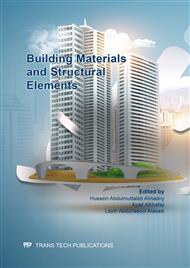p.88
p.97
p.110
p.121
p.130
p.139
p.147
p.157
p.177
Effect of Polypropylene Fibers on some Mechanical Properties of Concrete and Durability against Freezing and Thawing Cycles
Abstract:
This investigation aims to improve some of the mechanical properties of concrete such as compressive strength, flexural strength, and modulus of elasticity, by using different percentages of polypropylene fibers, and also studying the durability of concrete for freeze-thaw cycles. the study shows a small increment in compressive strength due to adding fibers which were 28.3% compared with increment in flexural strength which was perfect (about 191%), modulus of elasticity also increased by adding fibers. The durability of concrete against freezing-thaw cycles for all mixes was studied. Fiber-reinforced concrete shows more durability against freezing-thawing cycles and less reduction in strength compared with reference mixes without fibers,21.5% reduction in strength for optimum polypropylene fiber concrete while the reduction in strength for normal concrete was found 54.2% in this study.
Info:
Periodical:
Pages:
130-138
Citation:
Online since:
August 2021
Price:
Сopyright:
© 2021 Trans Tech Publications Ltd. All Rights Reserved
Share:
Citation:


